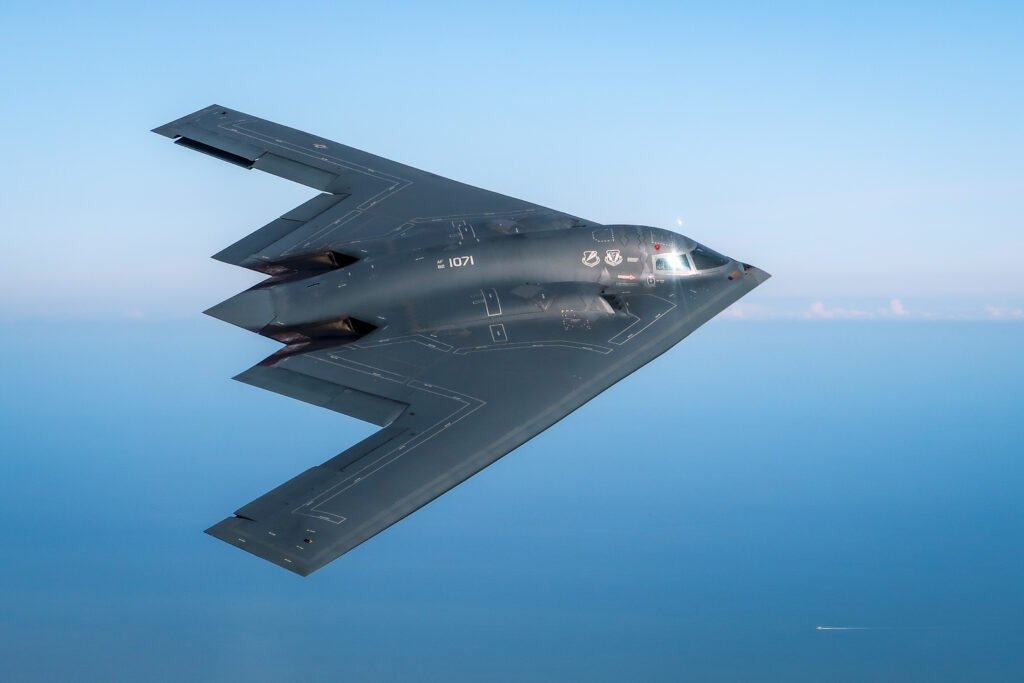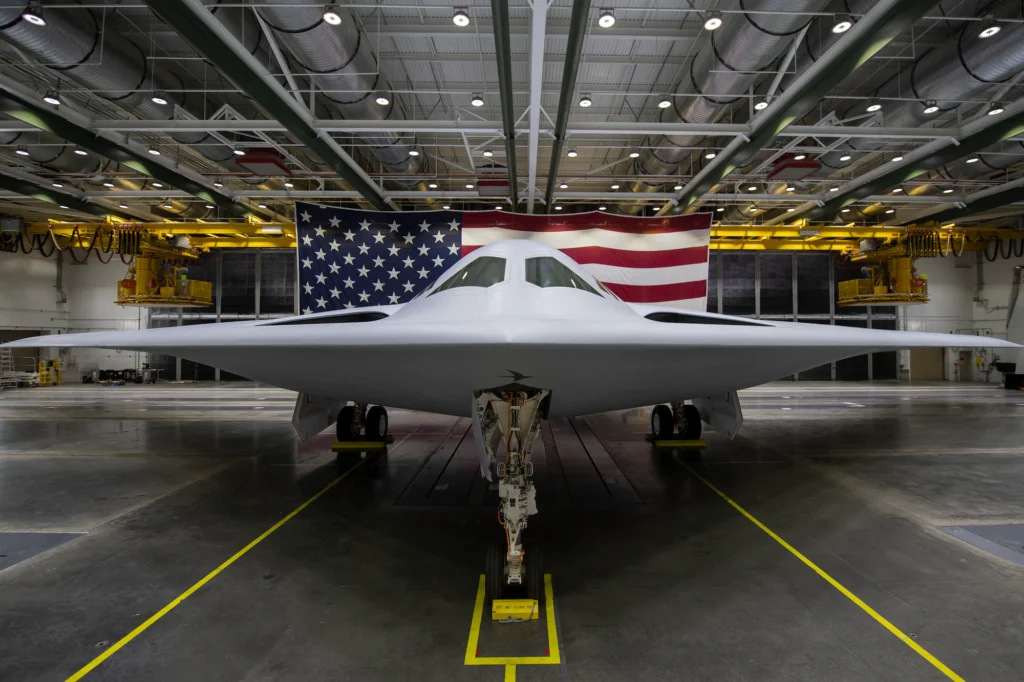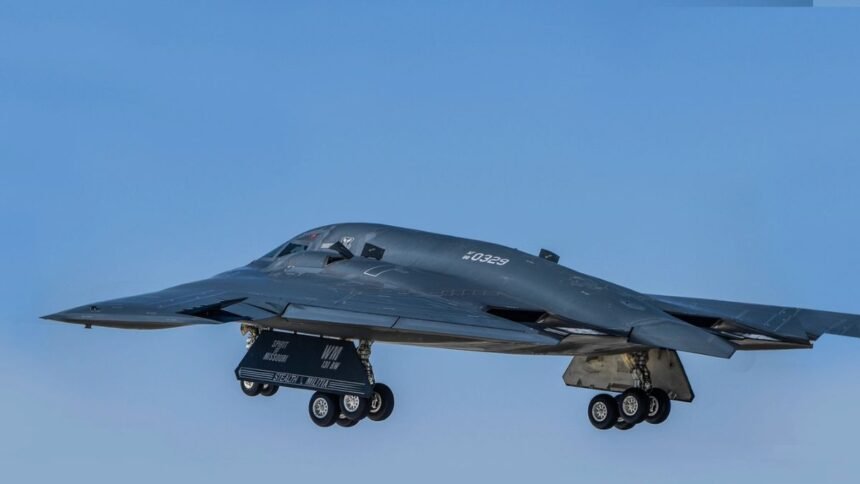Overview of the Incident
B-2 Spirit stealth bombers led a highly precise air strike on 21st June 2025, when the United States of America executed Operation Midnight Hammer against Iran’s deeply buried nuclear infrastructures. The centerpiece of this mission was the Fordow Enrichment Facility—a site in Iran that had long been fortified against conventional attacks. The strike even targeted the nuclear facilities of Natanz and Isfahan. Analysts regard the operation as one of the most advanced, superior, and technically complex air missions in modern military history.
- Overview of the Incident
- Aerial Power and Munitions Arsenal Overview
- Inside the B-2 Spirit Strike: Precision, Power, and Stealth
- The Timeline
- Planning and Coordination
- Iran’s View from Tehran: A Ghost Story
- How Iran Tried—and Failed—to Counter the Strike
- Air Defenses and Failed Interceptions
- Precision Strikes and Psychological Impact
- Why the B‑2 Still Matters
- The Price of Invisibility
- Can It Destroy the Earth?
- The B-21 Raider: What’s Next?
- Conclusion
- B-2 Spirit FAQ: Top Questions on the Stealth Bomber
- 1. What makes the B‑2 Spirit the stealthiest bomber in the world?
- 2. How does the B‑2 Spirit compare to upcoming bombers like the B‑21 Raider?
- 3. Has the B‑2 Spirit been used in real combat missions?
- 4. Why is the B‑2 Spirit considered better than ICBMs for certain missions?
- 5. What role does the B‑2 Spirit play in modern U.S. nuclear deterrence?
The US-led operation targeted Iran’s topmost fortified and secure underground nuclear bunkers with the assistance of stealth technology, precision-guided munitions, and advanced cyber-electronic warfare. The mission was more about sending a stern message to the world, especially amid escalating tensions with Russia, China, and Iran, than just about the damage to infrastructures. It raised the question again: Is the B-2 simply a relic from the Cold War, or is it still the most fearsome delivery platform in existence?
Aerial Power and Munitions Arsenal Overview
| Aircraft / Munition | Primary Role in the Raid |
|---|---|
| B‑2 Spirit | Penetrated Iranian airspace undetected; dropped 14 × 30,000 lb GBU‑57A/B Massive Ordnance Penetrators on Fordow & Natanz. |
| F‑22 Raptor | Escorted B‑2s & tankers; provided stand‑off electronic attack backup. |
| F/A‑18E/F Super Hornet | Suppressed enemy air defences (SEAD) and stood ready for dog‑fight contingencies. |
| EA‑18G Growler | Jammed early‑warning radars and SAM guidance channels. |
| KC‑135 Stratotanker | Enabled a 11,000 km round‑trip by refuelling the force over the Mediterranean. |
| RC‑135 Rivet Joint | Relayed real‑time electronic intelligence to the strike cell. |
| Tomahawk cruise missiles | Launched from USS Florida in the Gulf of Oman to neutralise Isfahan’s above‑ground nodes. |
| AGM‑88 HARM | Fired from Growlers to blind Iranian radar the moment jamming ceased. |
B-2 Spirit Strike Force: Stealth and Support in Action
B-2 Spirit Bombers: Among the stealthiest military aircraft, the B-2 Spirit infiltrated Iranian airspace undetected using advanced stealth tech and radar-absorbing coatings. Its low radar signature enabled precision strikes on fortified targets.
F-22 Raptors: Deployed mainly to escort B-2 bombers and tankers over the Persian Gulf during withdrawal. Also served as electronic warfare backup.
✈️Discover the full F‑22 Raptor vs J‑20 Mighty Dragon standoff story now.
F/A-18E/F: Super Hornets escorted stealth bombers, suppressed enemy air defenses, and engaged in dogfights. Their versatility suited dynamic threat environments.
EA-18G Growlers: Provided electronic jamming of early warning radar, SAM guidance systems, and enemy aircraft.
KC-135 Stratotankers: Refuel tankers supported long-endurance missions by refueling B-2s and escorts mid-air.
RC-135 Rivet Joint: Conducted electronic intelligence and relayed radar sweeps to strike units.
GBU-57A/B: A 30,000-pound GPS-guided bunker buster that penetrates 200 feet of concrete. Rear fuse allows delayed detonation. Only B-2s can carry it.
Tomahawk Missile: Long-range, subsonic missile flying low to evade radar. Uses GPS and INS navigation. Launched from submarines like USS Florida.
🧨 Want to know more about the top 5 anti-ship cruise missiles? Dive into the full list now.
AGM-88 HARM: Radar-homing missile tracking electromagnetic signals to destroy air defenses. Deployed from Growlers to disable Iranian radar and SAMs. About 120+ platforms dropped ~420,000 pounds of munitions, including 14 bunker busters and 20+ cruise missiles—serving more as a global signal than just structural damage.
Inside the B-2 Spirit Strike: Precision, Power, and Stealth
The Timeline

T‑30 min – EA‑18Gs initiate wide‑area jamming, Rivet Joint begins high‑fidelity sweeps.
02 h 43 (Iran local) – The US drops the first GBU-57A/B over Fordow, and seconds later targets Natanz.
+8 min – Tomahawks ripple in from the southeast toward Isfahan.
+20 min – B‑2s exit on a northern track, Iranian S‑300s and Bavar‑373s still searching empty sky.
+6 h – Spirits refuel over the Med, cross the Atlantic and recover to Whiteman AFB, Missouri.
Planning and Coordination
On 21st June, in the early hours of the morning, the strike commenced approximately at 02:43 AM local time in Iran (UTC+3:30). The time selected was strategic so as to exploit low civilian activity and reduced radar vigilance in the locations. Coordinated electronic disruption operations and radio silence began 30 minutes before weapons release to ensure optimal penetration conditions and to prevent any breach. The mission was meticulously and precisely planned over several weeks by the U.S. Strategic Command in collaboration with CENTCOM and AFRICOM, as confirmed by MoD. Multiple satellites captured and delivered real-time, improved surveillance data. Reconnaissance conducted by the RC-135 and Human Intelligence (HUMINT) guaranteed precise planning of the tactical strategy and operation.
Whiteman Air Force Base in Missouri, USA, gave the mission green-lit and then launched it. The coordinates are 38°43’44″N, 93°33’33″W.
Aircraft conducted mid-mission aerial refuelling in the central Mediterranean Sea. The coordinates are 34°01’03″N, 20°56’47″E (approximately).
The Tomahawk cruise missiles launched by USS Florida, SSGN-728, were from the Arabian Sea near the Gulf of Oman, approximately.
| Target | Coordinates | Munition Dropped |
| Fordow Enrichment Facility | 34°53’02″N 50°59’50″E | GBU-57A/B Massive Ordnance Penetrator (MOP) |
| Natanz Nuclear Facility | 33°43’30″N 51°43’32″E | GBU-57A/B Massive Ordnance Penetrator (MOP) |
| Isfahan Nuclear Technology Center | 32°35’02″N 51°50’42″E | Tomahawk Land Attack Missiles |
Iran’s View from Tehran: A Ghost Story
Iranian state media condemned the raid as an “act of war,” accusing the U.S. of violating sovereignty without warning. The real shock, however, was technological—layered defenses, including Russian S‑300s, detected nothing until bombs hit. Interceptors from Shahid Babayi Air Base failed to gain radar lock or visual, with Growler jamming and the B‑2’s radar stealth rendering them invisible. The West showed its readiness to deny Iran nuclear capabilities by force. While U.S. claims pointed to minimal collateral damage, Iranian reports mentioned civilian panic, displacement near Isfahan, and defense mobilization in Tehran and Bandar Abbas. Regional analysts had long warned of retaliatory cyber and asymmetric warfare. The incident exposed not just a military gap but a psychological blow—challenging national pride and regime legitimacy.
How Iran Tried—and Failed—to Counter the Strike
Air Defenses and Failed Interceptions
Iran activated its layered air defense systems, including Russian-supplied S-300 batteries and domestically produced Bavar-373 systems, in response to the strike. However, the B-2’s radar-evading capabilities rendered these systems virtually ineffective. According to regional defense observers, Iran’s
radar operators near Fordow and Natanz received no early detection warnings. The B-2s operated under strict communication silence and entered Iranian airspace from a low-observable corridor through Iraq, catching local defenses off guard.
Precision Strikes and Psychological Impact
Shahid Babayi Air Base interceptors scrambled minutes after the first detonation but failed to acquire any visual or radar lock. Accompanying U.S. EA-18G Growlers jammed Iranian surface-to-air missile guidance. Tehran later claimed it fired at “unidentified objects” near Qom and Isfahan, but post-strike analysis confirmed no hits. B-2 bombers deployed GBU-57A/B bombs from high altitude, placing Iranian short-to-medium-range air defenses out of range and leaving them as sitting ducks.
Iran’s military post-strike initiated multiple high-profile drills and anti-air rehearsals to restore public confidence, but it already created a dent in the dependency on the defense systems, exposing a significant vulnerability. Even with their own domestic and Russian radar coverage, the nation’s most guarded sites were not invulnerable to modern stealth capabilities. Some B-2s flew decoy patterns over the Pacific while the strike team approached via the Middle East. Aerial refuelling was done near RAF Akrotiri in Cyprus. As per sources, one of the pilots in the operation was a female Air Force officer—marking a historic first for B-2 combat missions. Satellite imagery confirmed the collapse of Fordow’s tunnel infrastructure within hours. The situation served as a grim lesson for the world that in the evolving nature of 21st-century air power—where even a sovereign nation’s most sensitive installations can be
reached, struck, and erased without warning or defense.
Why the B‑2 Still Matters
- Global Reach, Local Surprise — 11,000 km unrefuelled range lets the bomber start and end its mission on U.S. soil, minimising political footprints abroad.
- Recallable Nuclear Option — Unlike ICBMs or SLBMs, a B-2 Spirit bomber can be waved off or retargeted in flight.
- Psychological Deterrence — Even one airframe over a target nation signals that no bunker is safe.
- First Night Knock out — Stealth eliminates the need for a large escort “package,” slashing risk and radio traffic
The Price of Invisibility
- Acquisition cost: ≈ $2.13 billion per jet.
- Operating cost: ≈ $135,000–150,000 per flight hour, excluding the post-mission maintenance.
- Maintenance ratio: ~119 hours of wrench‑turning per flight hour, RAM coating demands climate‑controlled hangars.
- Support Chain: Over 1,200 ground crew personnel, including logistics, maintenance, cyber, and intelligence cells, carried out the operation.
Critics call it a “billion‑dollar diva,” but proponents argue that comparing one B‑2 strike to fleets of cheaper drones ignores the mission, destroying ultra‑hard targets 30 m underground, half‑a‑world away, on the first try.
| Platform | Stealth | Precision | Payload (lb) | Recallable? | Combat‑proven vs dense IADS |
|---|---|---|---|---|---|
| B-2 Spirit | ★★★★★ | ★★★★★ | ~40,000 | Yes | Yes |
| B‑52H | ★☆☆☆☆ | ★★★☆☆ | ~70,000 | Yes | No |
| Tu‑160 | ★☆☆☆☆ | ★★☆☆☆ | ~88,000 | Yes | No |
| H‑6K | ★☆☆☆☆ | ★★☆☆☆ | ~26,500 | Yes | No |
| Minuteman III (ICBM) | ☆☆☆☆☆ | ★☆☆☆☆ | ~1,150 | No | N/A |
| Trident II (SLBM) | ☆☆☆☆☆ | ★☆☆☆☆ | ~2,800 | No | N/A |
B-2 Spirit vs Global Bombers: Why It Still Sets the Standard
- The B-2 Spirit bomber excels in all major areas required for a go-to package in an advanced military-grade aircraft—stealth, precision, and mission flexibility. These traits make it the perfect choice for surgically striking high-value or time-sensitive targets. The B-21 Raider (upcoming) retains the B-2’s strengths while improving cost efficiency, stealth, and modularity. Analysts believe it will play a dominant role in future long-range strike and nuclear deterrence missions after the B-2 squadrons retire.
- ICBMs and SLBMs provide guaranteed reach and response speed but lack flexibility and recallability and are politically escalatory.
- B-52s and Tu-160s, even though capable of carrying more weapons, have major cons like they are still vulnerable in modern contested environments without a heavy escort.
- The H-20, a one-of-a-kind strategic bomber of Chinese origin (projected), is expected to rival and compete, as per sources, with its U.S. counterparts, the B-2/B-21, in stealth and range but remains unproven in operations or deterrence effectiveness.
Only the forthcoming B‑21 Raider promises to blend equal stealth with lower sustainment costs and optional unmanned operations but it has yet to see combat.
Can It Destroy the Earth?
The short answer is no—the B-2 cannot “destroy the Earth.” But it can certainly change the balance of power on it. Each B-2 can carry up to 16 nuclear bombs, including B-83s (thermonuclear gravity bombs with yields exceeding 1 megaton) or newer B-61 mod variants with adjustable yields.
In theory, dozens of urban or hardened strategic targets can be eliminated by a full squadron strike in a first-strike scenario. The B-2’s power lies more in its precision, stealth, and psychological deterrence than in planetary destruction. It wasn’t designed to wipe out all of the continents; it is built to silently sneak past radars and hit at the heart of an enemy’s nuclear command structure with surprise and even escape before the retaliation hits them. Moreover, nuclear doctrine and arms control treaties make the use of such weapons extremely unlikely outside an existential war. So, while it cannot destroy Earth, it can very much influence who controls it
The B-21 Raider: What’s Next?

The B-21 Raider was developed under the Long-Range Strike Bomber (LRS-B) program which represents a leap in generation. Built with open-architecture design, it integrates:
- AI mission planning
- Electronic warfare capabilities
- Hypersonic payload potential
- Optional unmanned operation
The Raider is designed not only to avoid detection but also to operate autonomously in contested environments similar to the current operation carried out. It flew its maiden flight in 2023, showcasing seamless multi-theatre data integration—a feature absents in current legacy bombers. It will eventually be replacing both the B-1 and B-2 bombers while also ensuring that strategic stealth capability remains exclusively American well into the 2050s.
Conclusion
The B‑2 began life as a Cold‑War nuclear penetrator. Three decades later, it remains the world’s only combat‑proven platform that can fly halfway round the globe, slip past modern air defences and pulverise a mountain bunker, all before breakfast back in Missouri. Until the B‑21 matures and proliferates, the B‑2 Spirit is still the ghost every hardened adversary has to fear. Yes, it is expensive. Yes, it is logistically demanding. But when a target 10,000 km away, buried under a mountain, is vaporized in silence without warning, interception, or collateral – the cost becomes relative. As the B-21 prepares to inherit its mantle, the B-2 will be remembered as the aircraft that defined American airpower in the post Cold War world. Not just for what it bombed but for the silence that followed.
B-2 Spirit FAQ: Top Questions on the Stealth Bomber
1. What makes the B‑2 Spirit the stealthiest bomber in the world?
A) The B‑2 Spirit uses radar-absorbent material, low-observable design, and infrared suppression to remain undetected in contested airspace.
2. How does the B‑2 Spirit compare to upcoming bombers like the B‑21 Raider?
A) While the B‑2 set the stealth standard, the B‑21 Raider aims to improve cost, modularity, and survivability with next-gen tech.
3. Has the B‑2 Spirit been used in real combat missions?
A) Yes, it has been deployed in Kosovo, Iraq, Libya, and more recently in high-risk precision missions requiring deep penetration.
4. Why is the B‑2 Spirit considered better than ICBMs for certain missions?
A) Unlike ICBMs, the B‑2 can be waved off or retargeted mid-flight, offering flexibility in high-stakes scenarios.
5. What role does the B‑2 Spirit play in modern U.S. nuclear deterrence?
A) The B‑2 forms a critical leg of the U.S. nuclear triad, capable of delivering both conventional and nuclear payloads with strategic reach.




